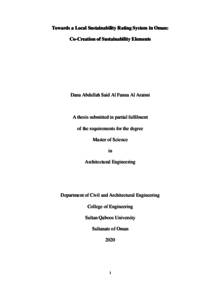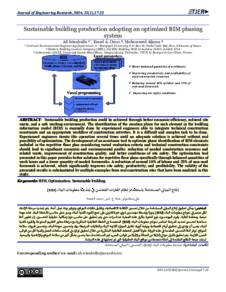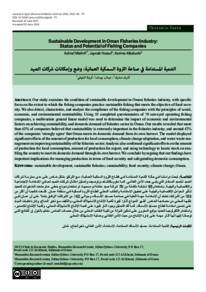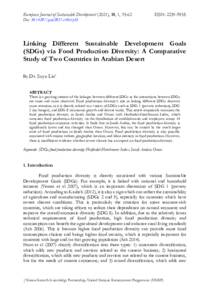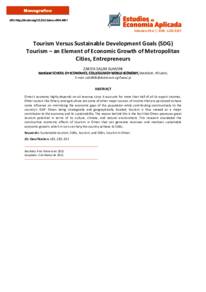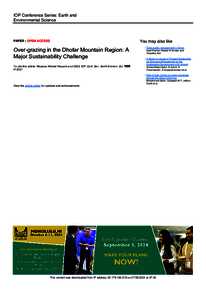Document
Towards a local sustainability rating system in Oman : co-creation of sustainability elements.
Publisher
Sultan Qaboos University.
Gregorian
2020
Language
English
Subject
English abstract
Sustainable development lies at the heart of Oman Vision 2040(Oman vision 2040,
2019). Although the economic; and human aspects of sustainable developments are
the main focus of the future direction of the country, the role of the built environment
as a key component of the Omani sustainable development agenda has been recently
acknowledged by the government. However, the development in this area is rather
slow when compared to other Gulf Cooperation Council (GCC) countries who have
already introduced sustainability rating systems for buildings such as Pearl Rating
System Tool in Abu Dhabi and Qatar Sustainability Assessment System. Most of these
systems were developed based on international sustainability rating systems i.e. LEED
and hence, adopted a top-down approach where the inspiration and cultural values of
the wider community might have been insufficiently considered.
In spite of the tendency towards a sustainable built environment in Oman, there has
been a lack of clear understanding of sustainability in a way that reflects Omani
people's aspirations, values, preferences and priorities. Equally important, earlier
endeavours in this field did not investigate sustainability components in the built
environment as perceived by stakeholders, including end-users and decision makers,
in Oman. This forms a major obstacle in the way of developing a local building
sustainability rating system. Therefore, the aim of this study is to elicit the Omani
stakeholder's perception of a sustainable built environment and identify sustainability
components as perceived by the Omani stakeholders. In addition, the study explores
the existence of differences among stakeholder groups in sustainability knowledge
based on socio-demographic factors such as gender, age, education level, influence
level, background and previous experience in sustainable projects.
The study adopted the social constructionism theory as an overarching approach and
hence, employed identification and mapping, elicitation, and consensus development
methods in a three-step data collection process. The first step involved stakeholder
identification and mapping using the power-vs-interest matrix technique. This technique allowed the researcher to identify and classify stakeholder groups into four
categories namely, crowd, subjects, context setters and players. This was followed by
an exhaustive freelisting exercise with a sample of 116 stakeholders who covered the
four categories outlined in the previous step. An effort was made to balance the sample
across stakeholder's categories and socio-demographic factors. The cut-off in sample
size was based on the notion of saturation point upon which no new terms are added
by any further addition to the sample size. After the freelisting data is filtered for
inconsistency and repetition following the method's protocol, the data was used to
calculate the Salience Index for each elicited unique term. The last step in the data
collection process involved a Pile sorting workshop during which representatives of
stakeholder groups worked collaboratively to develop consensus in order to categorize
the terms that were elicited in the previous stage. The data were analysed statistically
and inferentially using Statistical Package for Social Sciences (SPSS).
The results showed that the most salient terms for Omanis are Green Area followed
by Natural Ventilation and Using Solar Energy. It was also found that out of the 234
unique terms elicited, there are 27 terms that formed the core components of
sustainability in the built environment as perceived by Omanis i.e. most salient terms.
These terms are consensually categorized into four categories by the stakeholder
representatives during an interactive pile sorting workshop. These categories were
given titles based on the terms classified under each category by the stakeholder
representatives themselves: Materials and Construction, Social Requirements,
Efficient Design, and Cost Optimization. Therefore, it was concluded that the four
groups and the 27 terms represent potential structure -i.e. categories and their
indicators- for the development of an Oman-specific sustainability rating system.
Moreover, the inferential statistical analysis carried out (Mann-Whitney U test and the
Kruskale Wallis test) showed that some of the socio-demographic factors are
associated with differences in sustainability knowledge. In particular, gender,
education and stakeholder groups were found to have a significant effect on
sustainability knowledge among stakeholders. However, the analyses showed that
there were no significant differences in sustainability knowledge based on
stakeholders influence level (crowd, subjects, context setters and players), which in
turn suggests that those who have the power to change and influence do not necessarily
have better knowledge about sustainability.
Therefore, this thesis calls for immediate action to start a large-scale programmer to
promote sustainability knowledge and practices among all built environment
stakeholder groups including policymakers. Equally important, the thesis provides an
evidence-based structure to develop a local building sustainability rating system based
on Omani stakeholder's collective perception, values and aspirations.
Member of
Resource URL
Arabic abstract
تعد التنمية المستدامة الجوهر الأساسي التي بُنيت عليها رؤية عمان 2040 .حيث شملت المحاور الرئيسية الجوانب الاقتصادية والاجتماعية للنظرة المستقبلية التي تبنتها الحكومة الرشيدة نحو مسعاها للوصول لتنمية مستدامة مع تضمين البيئة المبنية كمحور أساسي لهذه التنمية .مع ذلك نجد بأن التطور في هذا المحور بطيء نسبيا مقارنة بشقيقاتها بدول مجلس التعاون الخليجي، حيث سبقتها هذه الدول بإدخال أنظمة تقييم وتصنيف للمباني المستدامة: كنظام اللؤلؤة في إمارة أبو ظبي بدولة الامارات العربية المتحدة والنظام القطري لتقييم الاستدامة في حيث أن معظم هذه الانظمة التي اعتمدت بدول الجـوار تم تطويرها بناءاً المباني. على أسس أنظمة عالمية لتقييم ( الذي انتهج في تكوينه مساراً رأسياً استدامة المباني كنظام الريادة في تصميم الطاقة والبيئة ) LEED من الاعلى بأن هذا النهج في طبيعته متمثل بأصحاب النفوذ والقرار والخبراء للأسفل وصولا إلى بقية أطياف المجتمع. علماً قد يهمش نسبيا في صورته الشاملة الاعتبارات الاجتماعية والثقافية الخاصة بالمجتمع المحلي. ً وعلى الرغم من التوجه الحكومي نحو خلق بيئة مبنية مستدامة، نجد هنالك فجوة في فهم وجهة نظر الشعب العماني وقيمه وتفضيالته وأولوياته لتحقيق بناء مستدام. حيث أن الجهود السابقة في هذا المجال لم تستطرد في البحث عن مكونات الاستدامة في البيئة المبنية كما تراها الفئات المعنية، بما في ذلك المستخدمون النهائيون للمبنى؛ وهذا قد يشكل عقبة رئيسية في مسيرة تطوير نظام تقييم مستدام للمباني المحلية. وعليه فإن هذه الدراسة تهدف إلى استخلاص مفهوم الاستدامة في البيئة المبنية من وجهة نظر الفئات المعنية من العمانيين وتحديد مكونات الاستدامة كما يرونها هم بشكل جمعي، والسعي الستكشاف احتمالية وجود اختالفات ما بين الفئات المعنية بنا ًء على العوامل الاجتماعية والديموغرافية مثل: الجنس والفئة العمرية والمستوى التعليمي ومدى قوة وتأثير مجموعات أصحاب الشأن والخبرة السابقة في المشاريع المستدامة. تبنت الدراسة في مسارها نظرية البناء الاجتماعي كنهج للدراسة والتي عرفت وشملت الطرق البحثية تحديد الفئات المعنية وتصنيفهم، واشراكهم في الدراسة. كما وظفت الدراسة طرق تطوير الاتفاق في عملية جمع البيانات التي تضمنت ثلاثة خطوات. الخطوة الاولى وهي تحديد الفئات المعنية وتصنيفهم باستخدام مصفوفة القوة-مقابل- التأثير. حيث تسمح هذه الطريقة للباحث بتحديد وتصنيف فئات أصحاب الشأن إلى أربع مجموعات بناء على قوتها وتأثيرها: الجمهور، والتابعون، وصائغوا السياق، والالعبون. فرداً تبع ذلك تطبيق طريقة التدوين الحرك مع عينة بحثية تضمنت 116 من الفئات المعنية من المجموعات الاربعة الموضحة في الخطوة السابقة. حيث تم بذل جهد لموازنة العينة من ناحية مجموعات الفئات المعنية والعوامل الاجتماعية والديموغرافية. ومن الجدير بالذكر بأن عينة الدراسة تم تحديدها بناء على فكرة "نقطة التشبع" وهي النقطة التي لم يحدث بعدها اضافة أية مصطلحات جديدة ضمن نطاق الدراسة مهما كانت الزيادة في عدد المشاركين في التمرين. و بعد تصفية بيانات التدوين الحر من التكــرار وعدم الاتساق، تم استخدام هذه البيانات لحساب مؤشر البروز Index Salience لكل مصطلح فريد تم الحصول عليه. xi ثم تم في الخطوة الثلاثة والاخيرة من عملية جمع البيانات عمل ورشة تفاعلية بين ممثلي للفئات المعنية بشكل تعاوني من أجل تصنيف المصطلحات التي تم الحصول عليها في المرحلة السابقة و وضعها في مجموعات. تم طوات السابقة إحصائياً واستنتاجياً بعد ذلك تحليل البيانات التي تم الحصول عليها باستخدام برنامج الحزمة الاحصائية للعلوم الاجتماعية )SPSS .) أظهرت النتائج أن أبرز المصطلحات بالنسبة للعمانيين لتعريف الاستدامة في البيئة المبنية هي المساحات الخضراء تليها التهوية الطبيعية و من ثم استخدام الطاقة الشمسية. وقد وجدت الدراسة أنه هناك 27 مصطل ًحا تشكل المكونات الاساسية لالستدامة بالنسبة لعينة البحث من العمانيين من بين 234 مصطل ًحا فريدًا تم التوصل إليه. وتم تصنيف هذه المصطلحات توافقيا إلى أربع مجموعات من قبل ممثلي الفئات المعنية. حيث تم الاجماع على منح هذه المجموعات عناوين بنا ًء على المصطلحات المصنفة تحت كل مجموعة هي: المواد والانشاء، الاحتياجات الاجتماعية، كفاءة التصميم، وتوفير الموارد. تمثل هذه المجموعات الاربعة والمصطلحات الـ 27 هيكلية لتطوير نظام تقييم الستدامة المباني خاص بسلطنة عمان. بالاضافة لذلك، أظهر التحليل الاحصائي الاستنتاجي الذي تم إجراؤه عن طريق اختباري )-Mann U Whitney )و ( Wallis Kruskale )أن هنالك فروق مرتبطة بمستوى الالمام المعرفي بالاستدامة وبعض العوامل الاجتماعية والديموغرافية. حيث وجدت الدراسة أن جنس المشارك ومستواه التعليمي، والخلفية المهنية والخبرات السابقة في مشاريع مستدامة لها عالقة بمستوى المعرفة بالاستدامة. كما أظهرت التحليلات أنه ال توجد فروق ذات دلالة إحصائية في مستوى المعرفة بالاستدامة بين مجموعات الفئات المعنية )الجمهور والتابعون وصائغوا السياق والالعبون(، مما يشير بدوره إلى أن أولئك الذين لديهم القدرة على التغيير والتأثير ليسوا بالضرورة لديهم معرفة أفضل حول الاستدامة من الاشخاص الاقل تأثيرا. وعليه تدعو هذه الاطروحة إلى اتخاذ إجراء فوري لبدء برنامج واسع النطاق لتعزيز المعرفة والممارسات المستدامة بين جميع فئات أصحاب المصلحة في البيئة المبنية بما في ذلك صانعي السياسات. كما توفر نتائج هذه الاطروحة هيكلا قائما على الادلة لتطوير نظام تقييم الاستدامة المباني المحلية بنا ًء على الفهم الجمعي للفئات المعنية من العمانيين وقيمهم وتطلعاتهم.
Category
Theses and Dissertations

